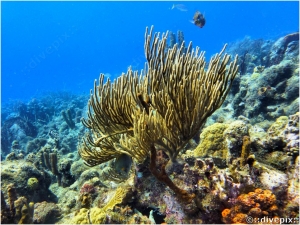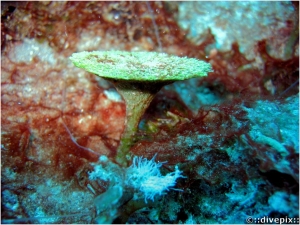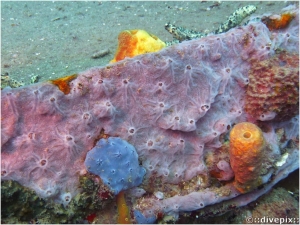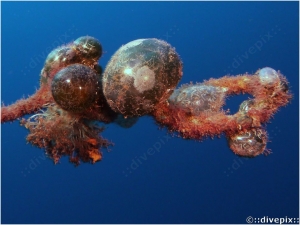




Eric H. Biass
Porous Sea Rod
| Aspect: | White or beige bush with numerous elongated branches. The ensemble can look very dense when polyps are extended as exemplified by the above picture. |
| Population: | Common. |
| Notable feature: | Owes its debatable designation to the fact that polyps retract absolutely flush with the surface of the branch, only leaving a light trace that gives the impression of a porous scar. |
| Environment: | Tends to settle in open waters on a solid rock base. |
| Behaviour: | - |
Long Sea Whip
| Aspect: | Long slim upward-growing twigs with few dichotomous off-white to orange branches, dotted with dark red spots, which actually are retracted polyp calix. |
| Population: | Not abundant. |
| Notable feature: | When extended, polyps feature red stalks, topped by glass-white tentacles and pinnules. |
| Environment: | Rocky substrates. |
| Behaviour: | - |
Shy Hamlet
| Aspect: | Bright yellow oval body with a resolutely protruding snout and large dark blue (to black) after body, although tail fin, belly and all other fins remain bright yellow. |
| Population: | Still scarce, but like the Queen Angelfish (inter alia) tends to reappear around Ilets Pigeon in 2016. |
| Notable feature: | Electric blue-surrounded elongated black patch between the eyes and the upper lip. Often mistaken from a distance for Rock Beauty Angelfish (q.v.) |
| Environment: | Close to bottom, around rocks and coral boulders that offer quick shelter. |
| Behaviour: | Wary, but may remain still if approached cautiously. |
Flat-top Bristle Brush
| Aspect: | Green cocktail cup-shaped fibrous structure with flatish top surface on a long slim stem. |
| Population: | Occasional. |
| Notable feature: | Appears as a mass of tightly bound fibres. |
| Environment: | Occurs in sandy areas. |
| Behaviour: | - |
Peach Encrusting Sponge
| Aspect: | A pale peach-coloured spreading mass with translucent excurrent chimneys fed by radially disposed translucent veinous surface galleries. The tips of these galleries interconnect with those of neighbouring networks. |
| Population: | Relatively common. |
| Notable feature: | Gelatinous aspect of the excurrent feed galleries surrounded by numerous and very visible incurrent pores. |
| Environment: | Tends to grow on even surfaces. |
| Behaviour: | - |
Sea Pearl
| Aspect: | Bottle-green polished egg. It is a unicellular (single cell) element and one of the largest amongst the algae, and in the Plant Kingdom for that matter. |
| Population: | Common. |
| Notable feature: | Shiny when not covered in encrusting algae; looks like made of glass. |
| Environment: | Affixes to any substrate providing adequate grip to its hair-thin attachments. |
| Behaviour: | - |
Green Bubble Weed
| Aspect: | Irregular green cushion-like mass with blistered surface. |
| Population: | Common in harbour areas (in other words not an amateur of crystal clean water). |
| Notable feature: | Each "blister" actually is a bubble cell. |
| Environment: | Attaches to rocks and dead coral. |
| Behaviour: | - |
Y-Branched Alga, or Y Branched Alga
| Aspect: | Flat blades, usually green or green with blue or brown tones, that fork off in Y patterns - hence their English designation. Can spread over relatively wide surfaces. |
| Population: | Widespread. |
| Notable feature: |
Belongs to the Brown Algae category in spite of its usually predominent green colour (algae are subdivided into four colours: Brown, Green, Red and Blue-Green. |
| Environment: | Can grow over many substrates, and as exemplified by some of the photographs herewith, can even develop over leaf corals. |
| Behaviour: | - |
Pink Fuzz Ball
| Aspect: | Pinkish Very light cottonwool-like mass (the double picture below shows sesitiveness to the slightest swell). Can be found in the form of small ovoid fuzzy masses of cottonous fibres anchored by their base to a coral or rock substrate or as a similar, but more spread mass entangled in the branches of corals. |
| Population: | Common, but needs a "trained eye" to spot them. |
| Notable feature: |
It appears that this alga has not been formally described, hence the lack of scientific designation. There in addition appears to be a number of controversial debates as to whether it really belongs or not to the alga category due to the alleged lack of nucleus in its cells. |
| Environment: | Snags on almost any substrate. |
| Behaviour: | - |
Mountainous Star Coral
Aspect:
|
Clusters of light brown corallites forming encrusting plates and mounds that can spread over several tens of centimetres. Inner edge of the corallite generally green. NOTE: The species was until recently known as Montastraea faveolata. It is part of a group that includes another two variations known as Orbicella annularis (formerly Montastraea annularis) and Orbicella franksi. All three belonged to the Faviidae family, but this has now also been renamed to Montastraeidae (in other words what used to be designation is now transferred to family name). This being said, the English and French vernacular names have remained unchanged. |
|
| Population: | Common. |
| Notable feature: |
Detailed descriptions in the little available literature on the Montastaelidae family (formely Faviidae) is scarce and often contradictory. However, it visually appears that the Mountainous Star Coral distiguishes itself from the Great Star Coral (q.v.) in having strongly fluted corallites with very prominent septa. Coloration (light brown most common around Ilets Pigeon) and bleaching depend on the nature or absence of zooxanthellae. Zooxanthellae are microscopic photosynthetic algae that live in symbiosis with corals. The latter provide shelter in exchange of which the zooxanthellae supply certain nutriments (including glucose and aminoacids relutling from photosynthesis) that enable them to eventually produce the calcium carbonate used to form their structure. When under stress - as happens with sudden temperature surges - coral expel their zooanthellae which causes them to lose their coloration in a phenomenon known as bleaching. |
| Environment: | Found at depths of a few metres down to 40 metres. |
| Behaviour: | Tentacles usually extend at night. |












